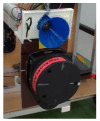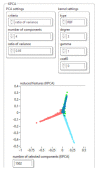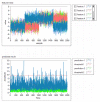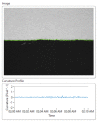Robotic Railway Multi-Sensing and Profiling Unit Based on Artificial Intelligence and Data Fusion
- PMID: 34696089
- PMCID: PMC8538696
- DOI: 10.3390/s21206876
Robotic Railway Multi-Sensing and Profiling Unit Based on Artificial Intelligence and Data Fusion
Abstract
This article presents the research and results of field tests and simulations regarding an autonomous/robotic railway vehicle, designed to collect multiple information on safety and functional parameters of a surface railway and/or subway section, based on data fusion and machine learning. The maintenance of complex railways, or subway networks with long operating times is a difficult process and intensive resources consuming. The proposed solution delivers human operators in the fault management service and operations from the time-consuming task of railway inspection and measurements, by integrating several sensors and collecting most relevant information on railway, associated automation equipment and infrastructure on a single intelligent platform. The robotic cart integrates autonomy, remote sensing, artificial intelligence, and ability to detect even infrastructural anomalies. Moreover, via a future process of complex statistical filtering of data, it is foreseen that the solution might be configured to offer second-order information about infrastructure changes, such as land sliding, water flooding, or similar modifications. Results of simulations and field tests show the ability of the platform to integrate several fault management operations in a single process, useful in increasing railway capacity and resilience.
Keywords: data fusion; infrastructure failure detection; machine learning; multisensory platform; railway automation; statistical data filtering.
Conflict of interest statement
The authors declare no conflict of interest.
Figures




























Similar articles
-
A Review on Technologies for Localisation and Navigation in Autonomous Railway Maintenance Systems.Sensors (Basel). 2022 May 31;22(11):4185. doi: 10.3390/s22114185. Sensors (Basel). 2022. PMID: 35684804 Free PMC article. Review.
-
Rethinking Autonomous Surgery: Focusing on Enhancement over Autonomy.Eur Urol Focus. 2021 Jul;7(4):696-705. doi: 10.1016/j.euf.2021.06.009. Epub 2021 Jul 8. Eur Urol Focus. 2021. PMID: 34246619 Free PMC article. Review.
-
Driver's behavioural changes with new intelligent transport system interventions at railway level crossings--A driving simulator study.Accid Anal Prev. 2015 Aug;81:74-85. doi: 10.1016/j.aap.2015.04.026. Epub 2015 May 6. Accid Anal Prev. 2015. PMID: 25956609
-
A framework to support human factors of automation in railway intelligent infrastructure.Ergonomics. 2014;57(3):387-402. doi: 10.1080/00140139.2014.893026. Ergonomics. 2014. PMID: 24670143
-
All-printed soft human-machine interface for robotic physicochemical sensing.Sci Robot. 2022 Jun;7(67):eabn0495. doi: 10.1126/scirobotics.abn0495. Epub 2022 Jun 1. Sci Robot. 2022. PMID: 35648844 Free PMC article.
Cited by
-
The Impact of Probe Angle and Swivel Length on Contact Point Identification in Coordinate Measuring Machine Measurements: A Case Study.Sensors (Basel). 2025 Mar 23;25(7):2008. doi: 10.3390/s25072008. Sensors (Basel). 2025. PMID: 40218522 Free PMC article.
-
Study on Multi-Heterogeneous Sensor Data Fusion Method Based on Millimeter-Wave Radar and Camera.Sensors (Basel). 2023 Jun 29;23(13):6044. doi: 10.3390/s23136044. Sensors (Basel). 2023. PMID: 37447893 Free PMC article.
-
Innovative Integrated Solution for Monitoring and Protection of Power Supply System from Railway Infrastructure.Sensors (Basel). 2021 Nov 25;21(23):7858. doi: 10.3390/s21237858. Sensors (Basel). 2021. PMID: 34883859 Free PMC article.
References
-
- Fact Sheets on the European Union—2021. [(accessed on 22 July 2021)]. Available online: https://www.europarl.europa.eu/ftu/pdf/en/FTU_3.4.5.pdf.
-
- Fact Sheet | High Speed Rail Development Worldwide. [(accessed on 25 July 2021)]. Available online: https://www.eesi.org/papers/view/fact-sheet-high-speed-rail-development-....
-
- Odziemczyk W., Woźniak M. Analysis of railway track geometry measurement methods usability. Transp. Overv.-Przeglad Komun. 2018;2018:40–50. doi: 10.35117/A_ENG_18_08_05. - DOI
-
- Pan P., Hu H., Yang X., Blaabjerg F., Wang X., He Z. Impedance Measurement of Traction Network and Electric Train for Stability Analysis in High-Speed Railways. IEEE Trans. Power Electron. 2018;33:10086–10100. doi: 10.1109/TPEL.2018.2836660. - DOI
-
- Dolara A., Leva S. Calculation of Rail Internal Impedance by Using Finite Elements Methods and Complex Magnetic Permeability. Int. J. Veh. Technol. 2009;2009:1–10. doi: 10.1155/2009/505246. - DOI
MeSH terms
LinkOut - more resources
Full Text Sources

